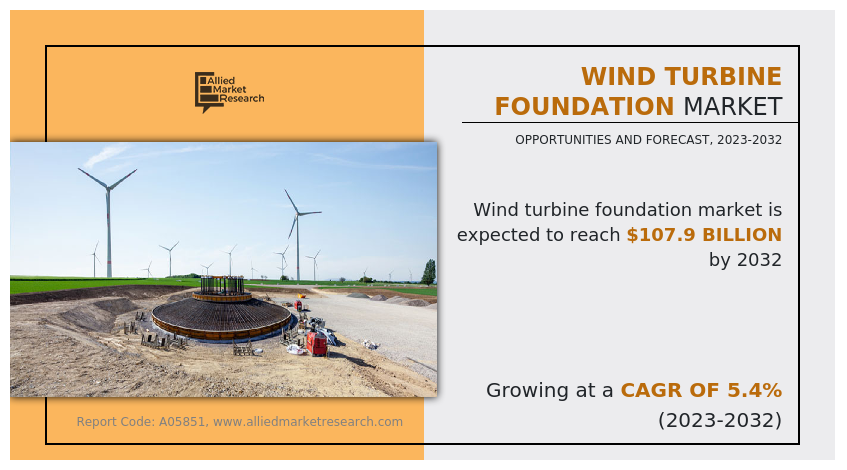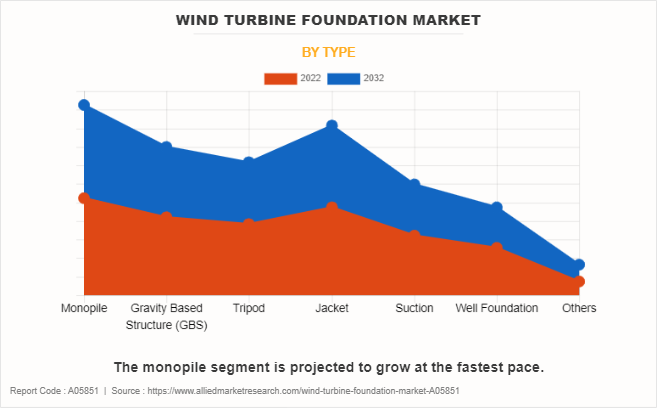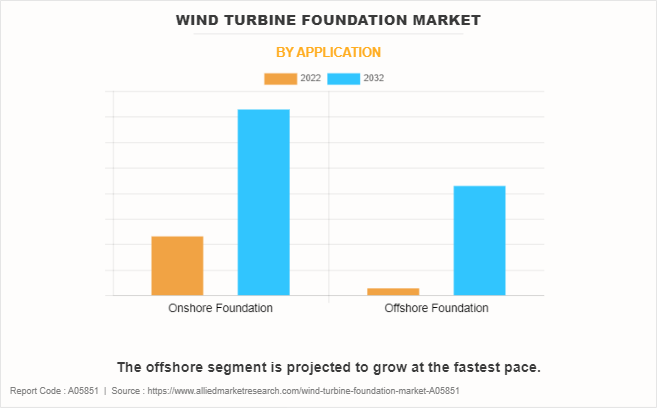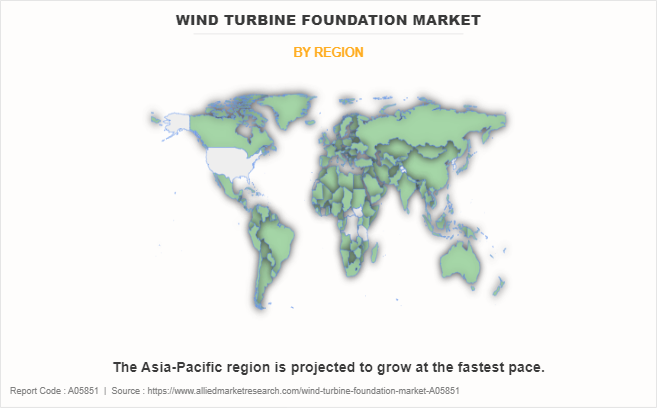Wind Turbine Foundation Market Research, 2032
The global wind turbine foundation market was valued at $63.0 billion in 2022, and is projected to reach $107.9 billion by 2032, growing at a CAGR of 5.4% from 2023 to 2032.
Key Report Highlighters:
- The report outlines the current wind turbine foundation market trends and future scenario of the market from 2023 to 2032 to understand the prevailing opportunities and potential investment pockets.
- The global wind turbine foundation market has been analyzed in terms of value ($ billion). The analysis in the report is provided for 4 major regions and more than 15 countries.
- The wind turbine foundation market is fragmented in nature with few players such as Dillinger, Offshore Wind Power Systems of Texas, OWEC Tower AS, Marine Innovation & Technology, Ramboll Group, TAG Energy Solutions, Fugro Renewable Services, Suzlon Group, Bladt Industries A/S, and MT Højgaard, which hold a significant share of the market.
- The report provides strategy planning and industry dynamics to enhance decision making for existing market players and new entrants entering the wind turbine foundation market.
A wind turbine foundation is a critical structural component that provides stability and support for a wind turbine. These foundations are designed to securely anchor the turbine to the ground, ensuring it remains stable and capable of efficiently converting wind energy into electricity. Wind turbine foundations come in various types, each suited to specific site conditions and turbine designs.

Wind turbine foundations are designed based on site-specific factors such as soil conditions, wind loads, and the size and height of the wind turbine. Engineers conduct geotechnical investigations and computer simulations to optimize foundation design. Foundations that require piles are installed by driving them deep into the ground using specialized equipment. Some foundations, such as gravity-based structures, rely on ballasting with water or other materials to increase their weight and stability. Components are often assembled on-site, especially for offshore installations, and transported to the location for installation.
Wind turbine foundations ensure the stability of wind turbines, allowing them to operate effectively and safely even in strong winds. Foundations are designed to support wind turbines of varying sizes, including multi-megawatt turbines. Professionally designed foundations require minimal maintenance over their operational lifetime. Some foundation types, especially those used offshore, involve complex design, fabrication, and installation processes. Transporting massive foundation components, particularly for offshore projects, be logistically challenging. Routine inspections are conducted to ensure the structural integrity and safety of wind turbine foundations.
Wind turbine foundations are essential components of both onshore and offshore wind farms, supporting the installation of wind turbines for electricity generation. Wind turbine foundations play a crucial role in the successful deployment and operation of wind turbines, contributing to the growth of renewable energy generation worldwide. The choice of foundation type depends on factors such as project location, water depth, and environmental considerations. Wind turbine foundation systems are integral to the growth of the wind energy sector. While challenges like high costs and logistical complexities exist, ongoing technological advancements and increasing global demand for renewable energy present promising opportunities for industry. In addition, regulatory support and environmental considerations play key roles in shaping the future of wind turbine foundation development and deployment.
The wind industry is shifting toward larger turbines, which require innovative foundation solutions capable of supporting increased loads. Environmental impact assessments and sustainability considerations are becoming more critical in foundation design and construction, particularly in sensitive offshore environments. Government policies and incentives, such as feed-in tariffs, tenders, and renewable energy targets, continue to play a pivotal role in driving wind energy development. Challenges related to the supply chain, including material availability and logistics, are impacting the cost and timeline of wind energy projects.
Market Dynamics
Advances in wind turbine technology, including larger and more efficient turbines, require robust foundations that support increased tower heights and rotor sizes. This drives innovation in foundation design. Wind energy projects stimulate economic growth by creating jobs in manufacturing, installation, and maintenance. Wind turbine foundations are essential components of these projects, contributing to job creation. The environmental benefits of wind energy, such as reduced air pollution and lower carbon emissions, drive the adoption of wind turbines and their foundations. These benefits align with climate change mitigation goals.
The environmental impact of constructing wind turbine foundations, especially offshore, poses challenges. Measures to mitigate these impacts, such as noise reduction during pile driving, are necessary, however, they add to project costs. Obtaining the necessary permits and regulatory approvals for wind energy projects is time-consuming and challenging. Compliance with environmental regulations is critical.
Offshore wind energy is a rapidly growing sector with vast untapped potential. This expansion presents opportunities for specialized foundation designs and construction techniques. The wind energy supply chain, including foundation manufacturing, is evolving and expanding. This presents opportunities for job creation and economic growth in regions with wind energy projects.
The wind turbine foundation market size is studied on the basis of type, application, and region.

By type, the wind turbine foundation market is divided into induction monopile, gravity-based structure (GBS), tripod, jacket, suction, well foundation, and others. The monopile foundation type dominated the wind turbine foundation market share in 2022. It is also expected to maintain its dominance during the projection period. Monopiles are most suitable for shallow to moderate water depths. In deeper waters, other foundation types such as jacket structures or gravity-based foundations are preferred. Transporting large monopiles to offshore locations is logistically challenging and requires specialized vessels. Monopiles, like other offshore wind foundations, require routine inspections to ensure their structural integrity and safety over their operational lifetime. Jacket foundations are known for their exceptional stability and load-bearing capacity. They are designed to withstand the dynamic forces generated by wind, waves, and tidal currents in offshore environments. The lattice structure resists both lateral and vertical forces.

By application, the wind turbine foundation market is bifurcated into onshore and offshore. The onshore foundation segment dominated the wind turbine foundation market growth in 2022. However, the offshore foundation segment is projected to dominate the growth during the wind turbine foundation market forecast period. The foundation type chosen for an onshore wind turbine project depends on site-specific factors and project requirements. Geotechnical studies and site assessments are conducted to determine the most suitable foundation solution based on soil conditions and other environmental considerations. In addition, local regulations and permitting requirements play a role in the foundation selection process. Each foundation type has its own advantages and disadvantages, and the choice should aim to provide stability and ensure the safe operation of the wind turbine while minimizing environmental impact and construction costs. Engineers and developers work together to make informed decisions about the most appropriate foundation for each specific project.

By region, the wind turbine foundation market analysis is done across North America, Europe, Asia-Pacific, and LAMEA (Latin America, the Middle East, and Africa). Asia-Pacific dominated the market share in 2002 and is projected to continue to dominate the growth owing to dynamic wind turbine foundation market trends fostering the market growth in the region. China is the world's largest onshore wind energy market. Common foundation types include concrete slab foundations, mat foundations, and various pile foundations. The market is evolving to accommodate larger turbines and to address soil conditions in different regions. China has been rapidly developing its offshore wind industry.
Monopile foundations, jacket foundations, and innovative designs like the "suction bucket" foundation have been used in offshore projects. India's onshore wind sector is growing steadily. Foundation types included monopiles, concrete slab foundations, and various pile foundations. The market was influenced by government incentives and renewable energy targets. Japan has been increasing its onshore wind capacity. Various foundation types, including concrete foundations and pile foundations, have been used. The market is driven by Japan's shift toward renewable energy sources following the Fukushima nuclear disaster.
The major players operating in the wind turbine foundation industry are Dillinger, Offshore Wind Power Systems of Texas, OWEC Tower AS, Marine Innovation & Technology, Ramboll Group, TAG Energy Solutions, Fugro Renewable Services, Suzlon Group, Bladt Industries A/S, and MT Højgaard. The companies adopted key strategies such as collaboration to increase their market share. The drivers, restraints, and opportunities are explained in the report to better understand the wind turbine foundation market scope.
This report further highlights the key areas of investment. In addition, it includes Porter’s five forces analysis to understand the competitive scenario of the industry and the role of each stakeholder. The report features strategies adopted by key market players to maintain their foothold in the market. Furthermore, it highlights the competitive landscape of key players to increase their market share and sustain the intense competition in the industry.
Policies, regulations, and standards across globe
Policies
- Renewable Energy Policies: Governments often have policies and incentives to promote the development of renewable energy, including wind energy. These policies may include feed-in tariffs, tax incentives, and subsidies that impact the economic feasibility of wind turbine projects.
- Environmental Policies: Environmental policies may require the mitigation of impacts on wildlife and ecosystems, which influence the design and location of wind turbine foundations.
- Energy Transition Goals: Many countries have set targets for transitioning to renewable energy sources, which drive the growth of wind energy projects. These goals often come with supportive policies to facilitate wind energy development.
- Export and Trade Policies: For international wind energy projects, trade and export policies influence the import of wind turbine components, including foundations, affecting project costs and timelines.
- Labor and Local Content Policies: Some regions may implement policies that encourage the use of local labor and materials in wind energy projects, impacting the supply chain for wind turbine foundations.
Regulations
- Environmental Impact Assessments (EIAs): Many countries and regions require EIAs before the installation of wind turbines and their foundations, particularly in sensitive or protected areas. These assessments evaluate the potential environmental impact of the project.
- Building Codes: Wind turbine foundations must comply with local building codes and regulations, which specify construction standards, safety measures, and load-bearing capacity.
- Permitting and Zoning: Local governments often have specific permitting and zoning regulations that dictate where wind turbines and their foundations be located. These regulations may address land use, setbacks, noise limits, and visual impacts.
- Safety Standards: Occupational safety regulations, such as those issued by OSHA (Occupational Safety and Health Administration) in the U.S. and similar agencies worldwide, govern safety practices during the construction and maintenance of wind turbine foundations.
- Grid Connection Standards: Wind farms must adhere to grid connection standards to ensure that the electricity generated by wind turbines be safely integrated into the electrical grid. These standards often include requirements related to grid stability and power quality.
Standards
- IEC 61400-6: This International Electrotechnical Commission (IEC) standard focuses on the design requirements for wind turbine foundations. It provides guidelines for both onshore and offshore wind turbines, covering aspects such as foundation design loads, structural integrity, and environmental conditions.
- ISO 1940-1: This standard addresses the balance quality requirements of rotors for wind turbines. Proper balancing is essential to reduce vibration and stress on the foundation and other components.
- DNVGL-ST-0119: Issued by DNV GL, this standard provides guidelines for the certification of wind turbine structures, including foundations. It covers design principles, materials, and structural analysis.
- ISO 13624-1: This ISO standard pertains to subsea structures and equipment, including offshore wind turbine foundations. It specifies requirements for design, fabrication, installation, and operation to ensure the integrity of subsea structures.
Key Benefits For Stakeholders
- This report provides a quantitative analysis of the market segments, current trends, estimations, and dynamics of the wind turbine foundation market analysis from 2022 to 2032 to identify the prevailing wind turbine foundation market opportunities.
- The market research is offered along with information related to key drivers, restraints, and opportunities.
- Porter's five forces analysis highlights the potency of buyers and suppliers to enable stakeholders make profit-oriented business decisions and strengthen their supplier-buyer network.
- In-depth analysis of the wind turbine foundation market segmentation assists to determine the prevailing market opportunities.
- Major countries in each region are mapped according to their revenue contribution to the global market.
- Market player positioning facilitates benchmarking and provides a clear understanding of the present position of the market players.
- The report includes the analysis of the regional as well as global wind turbine foundation market trends, key players, market segments, application areas, and market growth strategies.
Wind Turbine Foundation Market Report Highlights
| Aspects | Details |
| Market Size By 2032 | USD 107.9 billion |
| Growth Rate | CAGR of 5.4% |
| Forecast period | 2022 - 2032 |
| Report Pages | 226 |
| By Type |
|
| By Application |
|
| By Region |
|
| Key Market Players | NORDEX SE, Fugro Renewable Services, Offshore Wind Power Systems of Texas, Marine Innovation and Technology, SIEMENS AG, MT Hojgaard Danmark, Suzlon Energy Ltd, Bladt Industries A/S, Vestas Wind Systems A/S, SINOVEL WIND GROUP |
Analyst Review
According to the insights from the CXO’s, the wind turbine foundation market is driven by factors such as rapid sector growth, technological innovations, and offshore wind expansion, which is a testament to the industry's commitment to clean and sustainable energy sources. While challenges such as high costs and logistics persist, the industry's resilience and commitment to advancement continue to pave the way for a greener future.
Renewable energy integration especially in energy security, technological advancements, and environmental benefits for pushing through with renewable energy are the upcoming trends of Wind Turbine Foundation Market in the world.
Onshore is the leading application of Wind Turbine Foundation Market.
Asia-Pacific is the largest regional market for Wind Turbine Foundation.
Dillinger, Offshore Wind Power Systems of Texas, OWEC Tower AS, Marine Innovation & Technology, Ramboll Group, TAG Energy Solutions, Fugro Renewable Services, Suzlon Group, Bladt Industries A/S, and MT Højgaard are the top companies to hold the market share in Wind Turbine Foundation.
$107.9 billion is the estimated industry size of Wind Turbine Foundation by 2032.
Loading Table Of Content...
Loading Research Methodology...



